I've just entered my third month of the Ph.D here and getting into the swing of things. It takes around six months to a year in most labs until you can work completely independently. This is because there's a lot of know-how involved and the fine tuning of your methods really means the difference between an experiment working or failing. Some experiments take a few hours to do, but the more complex ones like a Yeast 2-Hybrid can take a couple of weeks in their entirety.
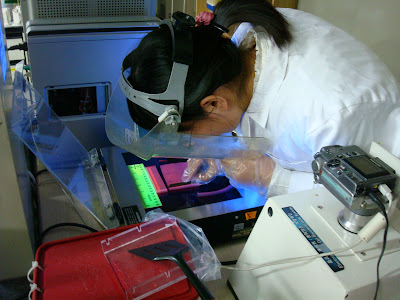
One feeling that you get used to pretty quickly is the one that comes after realising that you'll have to repeat a week's worth of work because you didn't get the results you were looking for. These troughs of feeling are compensated by the highs that you get when your experiments work nicely. When your experiments work, you feel like an invincible genius.
In the photo above, Chen Jing is cutting out a band of stained DNA with a razor blade. The gel that the DNA is sitting in is fluorescing pink. If you stain DNA with the right stuff, it becomes fluorescent under UV light. That's also why she's wearing the face shield, to protect her from skin damage.
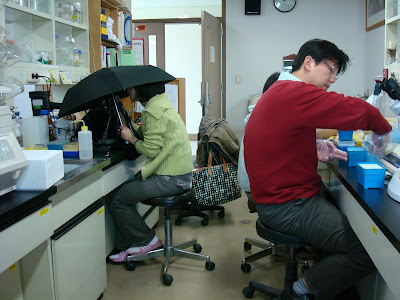
On the left is Se-kyung and on the right is Hoon. Hoon is my senior in the lab and I have to learn a lot of methods from him. However, he is very 'traditional' in a Korean sense, which I would best describe as displaying a rigid adherence to a hierarchical social structure to every last detail. Korea in general does have a more formal system of etiquette and respect based on age, but Hoon is a little more intense than your average Korean. His demeanor as well as his large fingers (which can make the intricacies of scientific work difficult at times) leads me to believe he may have been historically misplaced and actually belongs to the age of gladiators.
We're learning to get along with each other as time goes by.

In the last photo you may have noticed Se-kyung with an umbrella. When I first saw this here I did find it amusing, but since taking this photo I've seen it enough times and also had to use it myself. When you need to take a photo of something scientific, you need to do it carefully. Everything in the frame has to be lined up and zoomed in to the same measurements, on a tripod and with an umbrella to shield against reflections.
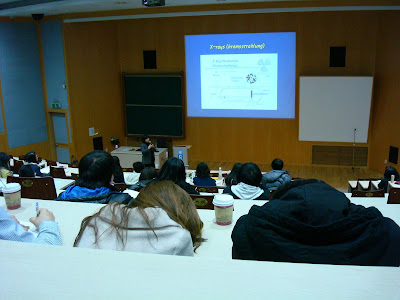
Last week I attended a 2 day safety course with a lot of other new students. It was all in Korean, which meant I only understood about 5%, but it was interesting to observe the lecture room behaviour here. Korean students will often put their heads on the table during lectures and fall asleep (they even have a special verb for it:
opdeurida). The lecturing professors, who I have to admit do appear boring even by lecturing professor standards, just continue on with the lecture like everyone's listening.
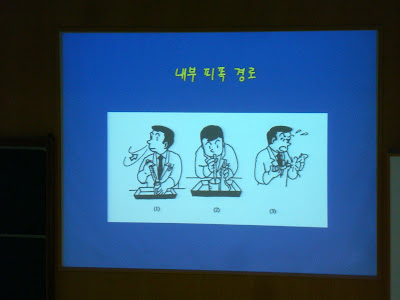
There was a test at the end, which was fairly straightforward. The content was a little silly at times, with such worthy safety advice as "If there is an unlabelled chemical on the bench, do not taste it" and "Don't store your lunch in the hazardous chemicals cabinet."
Safety education is vitally important to lab workers, but perhaps they also need to be testing us for common sense.
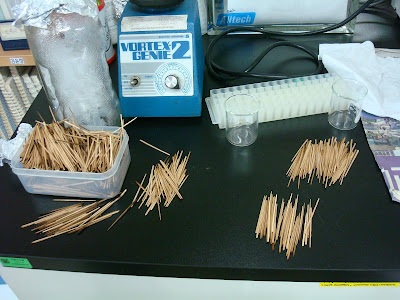
We do a fair bit of recycling here, which is good for the finances as well as the environment. I was mildly surprised to learn that they even recycle the toothpicks that we use to spot bacteria onto the petri dishes.
But I recently found out that this isn't done to save money. Do you know the two kinds of toothpicks that there are? The nice ones have pointed ends, while the cheaper ones are roughly cut and have a semi pointed end and a thicker one. The cheaper toothpicks are actually more useful to us, because the thicker end is a perfect size for scooping up a colony of bacteria, but the nice toothpicks are too pointy. In Korea they only sell the nice toothpicks, so the lab ordered some cheap toothpicks from overseas. Because they're not easy to come by here, we recycle them.
If you're thinking of a new business idea, try selling cheap toothpicks to Korean labs.
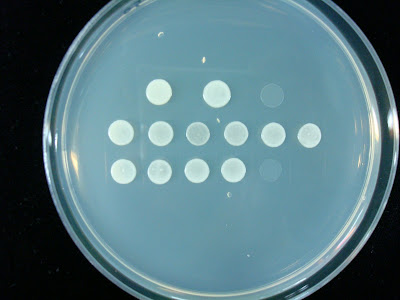
Earlier I mentioned one of the longer experiments called a Yeast 2-Hybrid. The theory behind it is fascinating and elegant, but getting it to work can be a nightmare. Basically it's a way to test if two different organic molecules interact with each other. Molecular interactions are behind almost every little thing that goes on in nature; from growing hair to producing acid in your stomach. By figuring out which molecules are interacting with each other, we can draw up a diagram and get an idea of what's happening in the bigger picture.
What a Yeast 2-Hybrid does is manipulate yeast cells so that they will live or die, depending on which molecules are interacting inside them. A good example of this is 'poison resistance', which is when the yeast can only survive poison if they have the correct interaction going on. In the photo above you can see that most of the yeast spots are nice and white, meaning that they survived. But there are two spots that are opaque, which means that they were unable to survive the poison. This tells us something about what is going on with the molecules that we are studying.
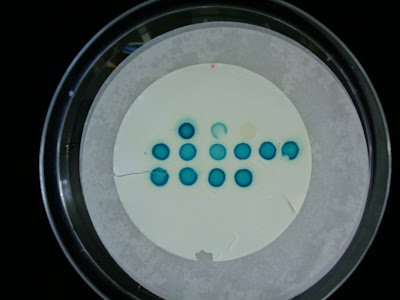
And in science, one experiment is never enough proof. What you need to do is repeat the experiment until you can convince your professor and the community that your results are meaningful. A good way to do this is to have experiments with different methods. If your experiments have different methods and use different stuff, but the results indicate the same conclusions, then you have a stronger basis for making a claim. This is why real scientists know that things like global warming and evolution are beyond reasonable doubt. These two 'theories' are supported through an immense range of scientific disciplines, from molecular mechanics to ecology and atmospherics. When such broad, independent and scientifically reliable sources all conclude the same thing, you can be confident that it's more trustworthy than someone who wrote a book saying it's all a big conspiracy.
Anyway, in the photo above is the same experiment but done with different chemicals. In the dish is essentially the same colonies of yeast, but they've been given chemicals that will turn blue if the result is positive. We can see that the same pattern emerges as in the previous photo, which gives us a more trustworthy result. Isn't life grand?

It was Se-kyung's birthday this week, so we celebrated with a cake and some Chinese food. Se-kyung is finishing up her master's degree this year. It's going to be Heather's birthday next week, so I'm probably heading back to Busan for the weekend.
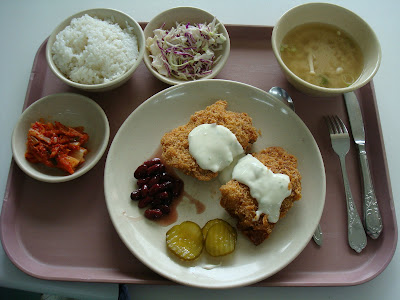
Here's a fried fish cutlet lunch that I had a while ago. The serving sizes are actually quite good and just enough to fill you up without going overboard. If you want more though, you can go back to the counter and get refills for free. The price of this meal was only W2,500 (about $2.50 Australian!).
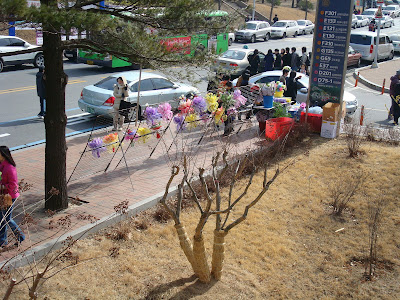
It was also graduation day recently. A whole lot of vendors came to the campus selling flowers, food and photography services. I look forward to the day when I graduate, but I guess I have a lot to learn before I can consider myself proficient in the field.
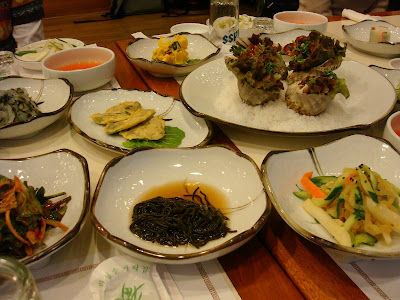
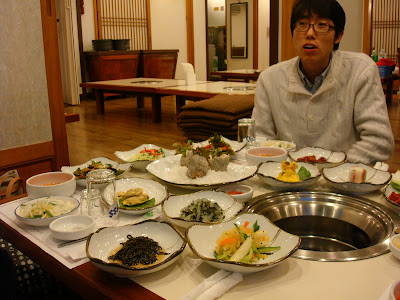
The professor took us out for a nice dinner last week too. We went to a traditional Korean barbecue place to welcome our newest lab member, Keonwoo. One day I'll hopefully get a photo of the professor to post here. He's one of the smartest people I've ever met and quite friendly, but I still haven't struck up the courage to snap a photo of him. Maybe one day when he's not looking, you'll get to see a photo of the back of his head.
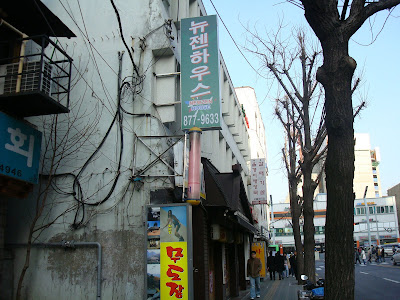
I'm still on the waiting list for the dormitories and my old place expired. So Hong-sup organised some new accommodation for me at the New Zen
koshiwon. These types of places are popular with students because they're cheap and usually conveniently located. Mine is 30 seconds away from the shuttle bus stop.
 Koshiwons
Koshiwons have shared facilities like kitchens and washing machines which give them a more communal atmosphere than regular lodgings, known as officetels.
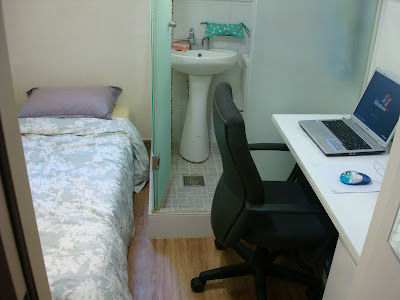
And here's the reason why they're so cheap. My room has enough standing space for one, but not enough floor space to do push-ups on. But it helps to keep the place tidy at least. I have free internet and a little TV too. Some people live permanently in these sorts of places, and I'm sure I could live here for a year or so. It's not so good for having friends over though.
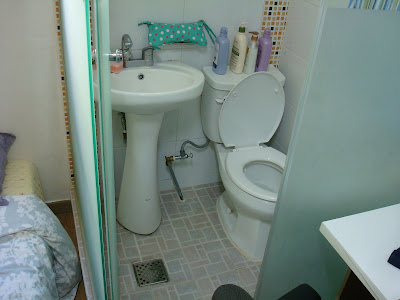
My room is one of the 'deluxe' rooms, which means I don't have to share my bathroom. The showerhead actually sprays over the whole bathroom area, including the toilet paper (which was an interesting discovery).
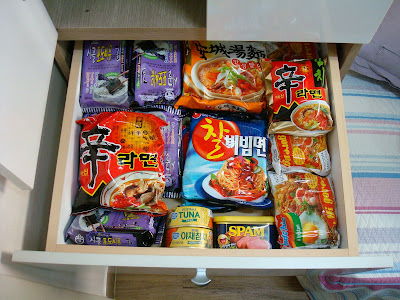
I packed all of my stuff from my previous place and carried it over. Instant noodles are the quintessential student food of our generation.
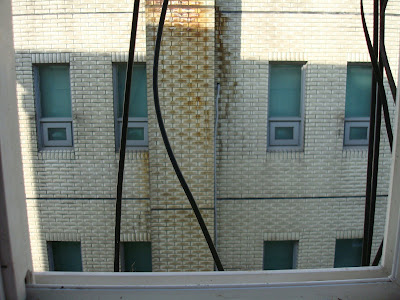
The view out the window isn't particularly spectacular, but sometimes I can see kids playing in the alley below. I stopped watching them after they discovered me leering down at them one day. I guess I'm not really a creepy old man, but there's no point in practising.
Maybe I should buy a periscope.
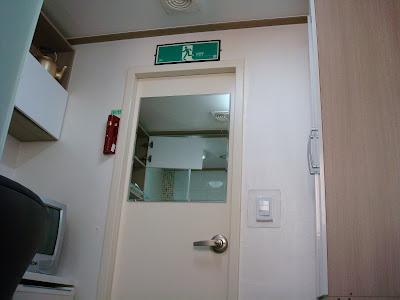
And one of the more comical things I found was this glow-in-the-dark exit sign above my door. Even in pure blindness, it would be difficult to not find your way out of the room.
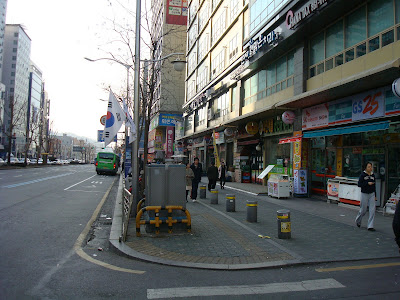
The area I'm in, which is named after the university's subway stop, has a more suburban feel to it. Conveniences are everywhere and I don't have to walk far to find what I'm looking for.
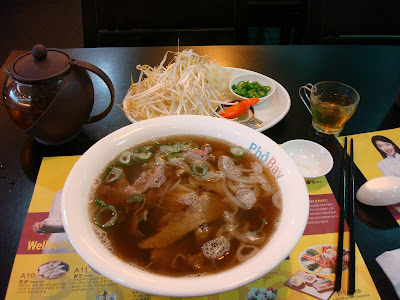
On the weekend I found a Vietnamese beef noodle shop. These are popular in Korea, and the taste is fairly good. But in Australia, there's a large Vietnamese community, so the beef noodles back home are excellent.
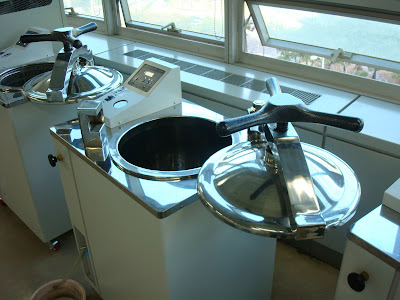
Back to the lab again. These days I'm pulling 8:40am until midnight as hours on occasion, but there are others here that do it more regularly. I always was a workaholic, so it doesn't bother me much. I enjoy the freedom that I have in organising my own timetable.
The machine in the photo above is called an autoclave. Because we need most of our equipment sterile before we use it, most things are autoclaved regularly. This machine applies high pressure, steam and heat to whatever is put inside. The result is that no bacteria can survive, and even viruses are broken down. Many people don't know, but bacteria and viruses are about as different as fish and rocks. Well, maybe not fish and rocks. More like fish and water.
You can see that the lid of the machine kind of looks like a submarine hatch. That's because this kind of seal is the best design for high pressure environments.
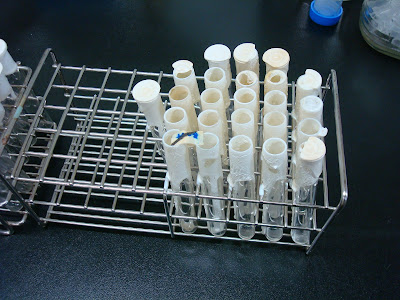
And if you autoclave things the wrong way, this is what happens. In this photo, the plastic lids of the test tubes melted and fused onto the tubes themselves, as well as the rack. We had to throw these away.

In the last blog post, I told you how we can get foreign DNA into bacteria by simply giving them a heat shock. Another way to do it is with this machine in the photo. It's called an electroporator and what it does is apply a short zap of electricity to your bacteria. What you do is plop the bacteria into a special tube with metal sides and mix them with the DNA you're interested in. The electrical charge pierces the cells and carries the DNA in with it, because DNA is negatively charged. But it all happens so quickly that the holes in the bacteria seal up fast enough that some of them can survive.
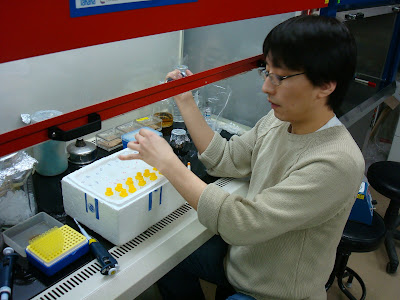
Here's our newest Ph.D student, Keonwoo, helping me to prepare the electrocompetent cells. Keonwoo is a funny guy and we get along well. He smokes a lot of cigarettes and his voice sounds a little like Smegol, but he's very chilled. His English name is Keanu, due to the similar spelling, but I pointed out that this was because the spelling was wrong. According to the revised romanisation of Korean, his name should be spelled Geonwoo. So I sometimes call him Geanu Reeves.
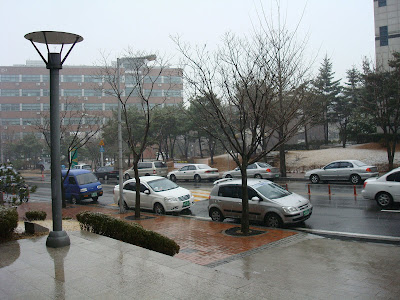
The weather has been warming up nicely, but the other day we had precipitation that was a mix between snow and rain. I'm sure there's a proper name for it, but I called it Snain. When spring fully arrives, I hope to start jogging again.
That's all from me! See you next time.
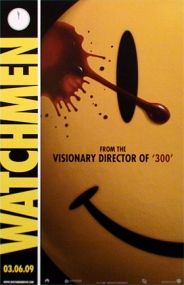






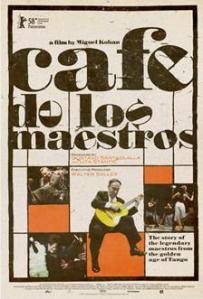

Recent comments